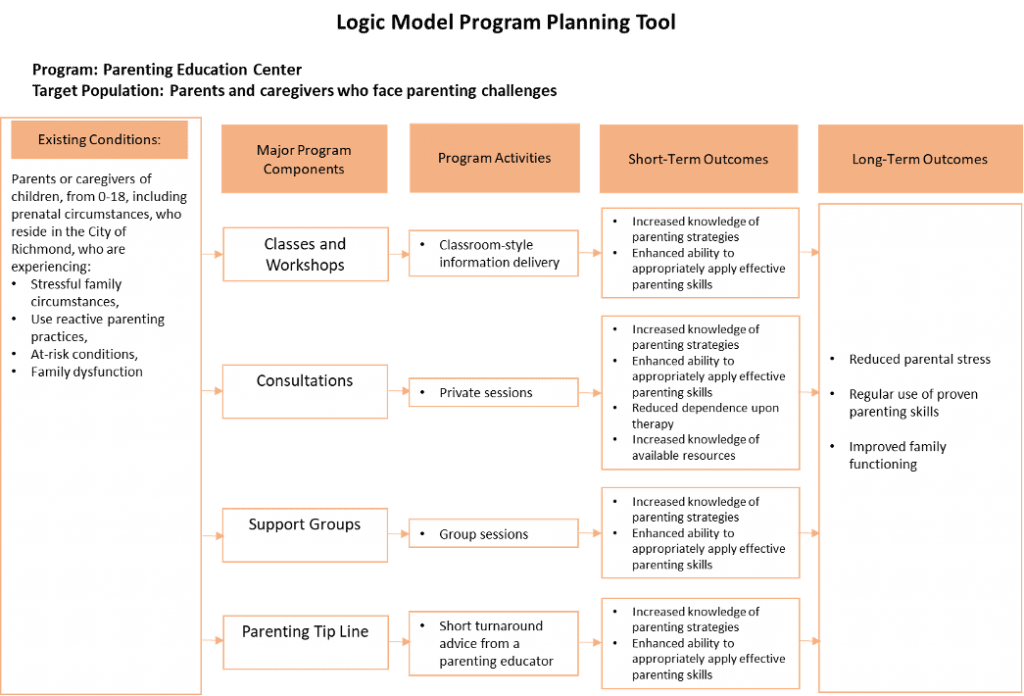At Knowledge Advisory Group, logic models are one of our favorite tools for both program design and evaluation strategy because they create the foundation for success.
What is a logic model?
At a high level, a logic model illustrates how a program is designed to work by showing linkages between program services and client outcomes. There are many different logic model formats with varying levels of detail about other aspects of the program. For example, many logic models include inputs (resources needed to provided program services) and outputs (measures of staff workload), as well as services and expected outcomes.
We like the logic model format shown below because it is relatively simple. In addition to identifying the target population, it includes the following information:
Existing conditions- The problem you are attempting to address.
Major program components- Closely related groups of activities that are logically related to existing conditions identified during the planning process.
Program activities- The services a program provides for its participants and the means through which the desired outcomes will be achieved.
Short-term outcomes- Achievements or improvements on the part of program participants that occur either during or immediately after program participation ends.
Long-term outcomes– Benefits or changes for program participants over an extended period of time.

What are the benefits of a logic model?
We love the logic model development process because it creates an opportunity for staff to participate in a series of in-depth discussions about what they can expect to achieve, given the services they provide. During these conversations, we often find there are conflicting views among staff about what they are doing and why they are doing it. Through logic model development, staff must come to a consensus on these issues. At the end of the process, staff have a shared understanding about the program’s purpose and strategy, which allows them to work together more effectively to support the organization’s mission. Logic models can provide other critical benefits to program success as well.
Program Design Framework- During the logic model development process, we encourage clients to consider if there is a logical flow between the program activities and outcomes they have identified. Many times, programs will come to the realization that the duration of services or the types of services offered are not sufficient to produce the client changes they had hoped to achieve. When this occurs, program design changes may be implemented to improve alignment between services and expected outcomes. If program design changes are not possible, outcomes may be revised to better reflect what may be reasonably achieved by the services provided.
External Communication Tool- Programs sometimes have difficulty providing a succinct explanation of what they do, especially if it involves complex and layered services. Similar to an “elevator speech,” logic models provide a clear and simple overview of program services and intended outcomes. They also demonstrate to those outside the organization that programs are well thought out, as well as preparedness to provide program specific data.
Program Evaluation Roadmap- Logic models also provide a useful roadmap for program evaluation. There should be a strategy for measuring each activity listed on the logic model to show program outputs, which may be used for implementation or process evaluation efforts. There should likewise be a strategy for measuring each short-term and long-term outcome on the logic model to assess changes among program participants, which may be used for an outcome evaluation.
Logic model development is not always a simple process, but it is extremely gratifying to watch organizations achieve clarity about a program’s purpose, strategy, and impact, which creates the foundation for success. Once this tool has been created, organizations may review it as often as necessary to ensure they stay on track and on mission.
If your organization does not have a logic model, or your logic model does not provide a clear and simple visual representation of your program’s services and intended outcomes, we recommend that you prioritize logic model development in 2021!
